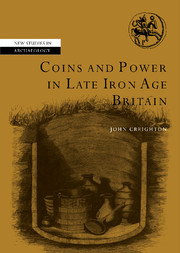Book contents
- Frontmatter
- Contents
- List of figures
- List of tables
- Preface
- Acknowledgements
- List of abbreviations
- Note on translations used
- Introduction
- 1 The Middle to Late Iron Age transition
- 2 Coin and the representation of individual authority
- 3 The Southern and Eastern kingdoms
- 4 Classical imagery and ideology in Britain
- 5 The location of Britain in the Roman world
- 6 Legends and language
- 7 Dynasties and identities
- 8 Conclusion and epilogue: from Britain to Britannia
- Appendix: A brief introduction to Iron Age coinage in Britain
- References
- Index of coin types
- General index
- NEW STUDIES IN ARCHAEOLOGY
3 - The Southern and Eastern kingdoms
Published online by Cambridge University Press: 22 September 2009
- Frontmatter
- Contents
- List of figures
- List of tables
- Preface
- Acknowledgements
- List of abbreviations
- Note on translations used
- Introduction
- 1 The Middle to Late Iron Age transition
- 2 Coin and the representation of individual authority
- 3 The Southern and Eastern kingdoms
- 4 Classical imagery and ideology in Britain
- 5 The location of Britain in the Roman world
- 6 Legends and language
- 7 Dynasties and identities
- 8 Conclusion and epilogue: from Britain to Britannia
- Appendix: A brief introduction to Iron Age coinage in Britain
- References
- Index of coin types
- General index
- NEW STUDIES IN ARCHAEOLOGY
Summary
For almost a century a family of gold coinage derived from Gallo-Belgic A circulated in Britain. The conservatism within the imagery and colour during this time was extraordinary. However, around the mid-first century BC a significant change took place. In the south-east, to judge by hoard evidence, much of this earlier coin disappeared, to be replaced by two totally new families of imagery. These were derived from Gallo-Belgic F, a continental coin rarely found in Britain. The first series of issues are collectively called British Q (S5), and circulated in Hampshire and southern Berkshire. Within a generation these coins had legends added to them, and we see them hailing the names of the Commian dynasty (S6–7). The coinage of the west (W5–9; the ‘Dobunni’) also derived from British Q. Meanwhile, in the east, a second series began with British L (E5-6), from which derived the coinage of Addedomarus (SE7), the Tasciovanian dynasty (E7–8), as well as some of the gold of East Anglia (EA6–7).
Not only do we find two totally new families of imagery beginning, replacing the existing stock of gold coin, but there was also a noticeable shift in the colour of that gold coin. The dominance of yellow gave way to red. Alongside the gold, silver coins came to be issued more commonly. It was as if the yellow ternary alloy had been rent asunder into two completely new metals: red-gold and white silver.
- Type
- Chapter
- Information
- Coins and Power in Late Iron Age Britain , pp. 55 - 79Publisher: Cambridge University PressPrint publication year: 2000



